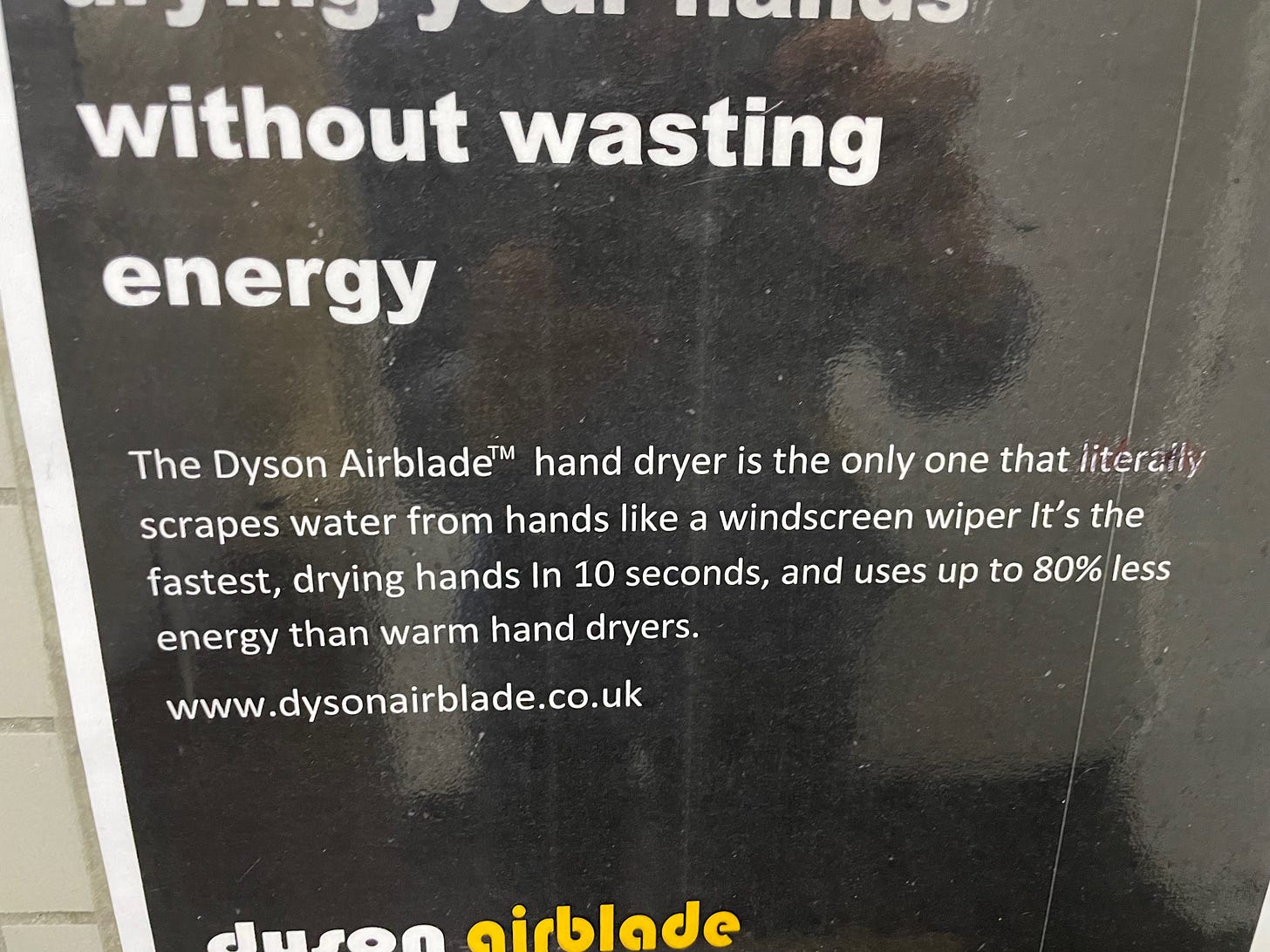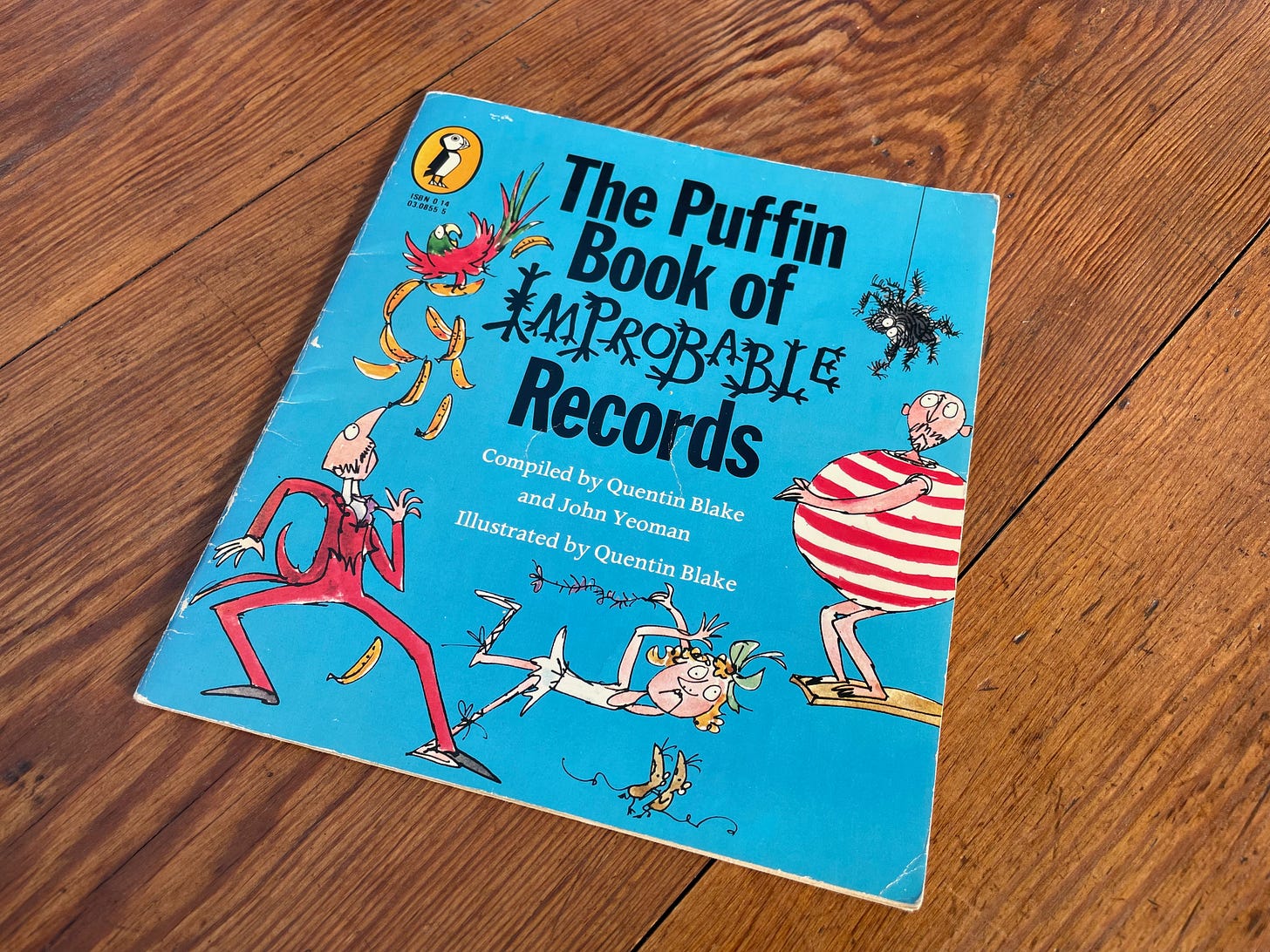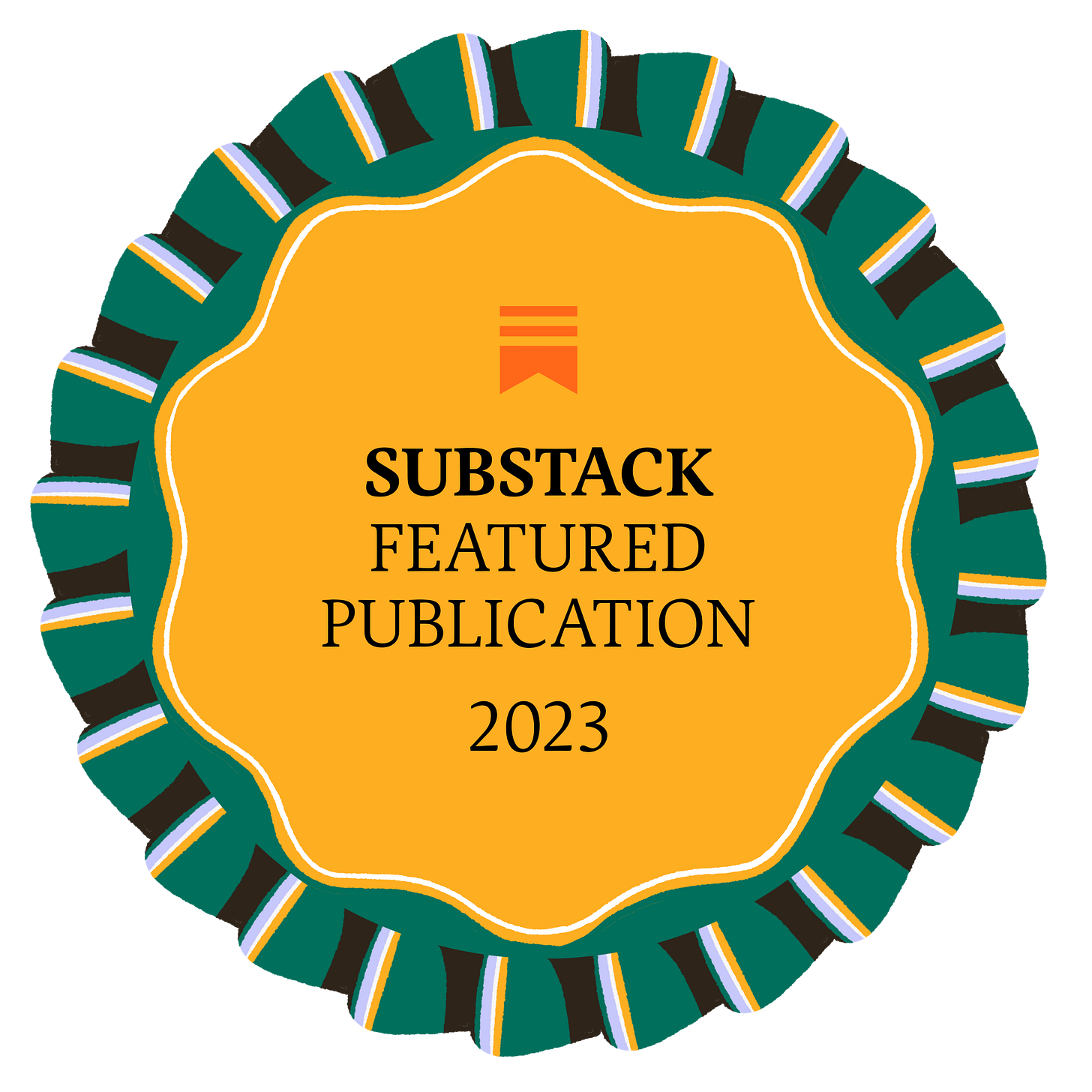In which Rebecca samples improbable marketing claims with a large pinch of salt and shares her doubts about the literal ability of a windscreen wiper to dry her hands.

Dear Reader,
In this era of internet marketing I am fascinated by ridiculously over-specific advertising claims being spouted by click-hungry spammers about the latest must-have product, and I have to admit that it’s hard not to be impressed by their attempts to present hyperbolic numbers as scientific data.
I’ve harvested some gems from my e-mail junk folder to show you.
A sender called Never Forget Anything claims this:
4,462 seniors swear by this Tibetan method
And Cramping has an intriguing question for me, and even explains why he or she was asking:
Have you ever poured vinegar on your legs?
It sounds stupid… And weird. But it can help you ERASE chronic pain within only 37 seconds.
That 37-second claim is extremely specific, and I can only assume that ‘erase’ had been intended as ‘ease’. A typo, surely? 🤔
To ‘erase’ and to ‘eliminate’ both mean the removal of something entirely. How can a percentage other than 100% be appended to those? But look:
It erases nerve pain by 43%...
It eliminates cramping by 67%...
And it’s 4X stronger (and safer) than any opioid.
Spam writers responsible for nonsense such as this require both a dictionary and a better sense of social responsibility.
Another e-mail sender tells me:
Click here now to find out the Costa Rican breakfast ritual that’s helping 18,761 people...
I love that the huge number is so ostentatiously random, but am perhaps a tiny bit suspicious at the use of the present continuous tense – is helping – rather than a statement about how many people this miraculous breakfasting practice has helped.
And the fact that it’s a ritual rather than an ingredient intrigues me. Hey, perhaps all I need to do to benefit from ‘help’ is to scramble my eggs anticlockwise? 🔄 🤔
Here in the UK the ASA – or Advertising Standards Authority – has stringent rules for claims made in advertising, and it is important that these be substantiated by evidence.
The Advertising Standards Authority (ASA) is the self-regulatory organisation of the advertising industry in the United Kingdom. The ASA is a non-statutory organisation and so cannot interpret or enforce legislation. However, its code of advertising practice broadly reflects legislation in many instances. The ASA is not funded by the British government, but by a levy on the advertising industry.
Its role is to “regulate the content of advertisements, sales promotions and direct marketing in the UK” by investigating “complaints made about ads, sales promotions or direct marketing”, and deciding whether such advertising complies with its advertising standards codes. These codes stipulate that “before distributing or submitting a marketing communication for publication, marketers must hold documentary evidence to prove all claims, whether direct or implied, that are capable of objective substantiation” and that “no marketing communication should mislead, or be likely to mislead, by inaccuracy, ambiguity, exaggeration, omission or otherwise”.
Reader, it is clear that while the spammers lack moral fibre and a gift for mathematics, they do not lack confidence. This has made me wonder whether overblown numbers do actually serve those called to benefit from them with some confidence of their own. Perhaps if I had a balance issue I would feel great about performing the exercise described below, simply from being told that so many people have already had impressive results:
This ‘foot stretch’ has restored perfect balance in over 112,928 people
Hang on a minute. Over 112,928 people? ‘Over’ followed by an immense and very specific number sounds extremely odd. Whatever is it that makes 112,928 a better choice than the accurate figure of, what, 112,929? 🤔
Reader, I’m taking over. I’m going to turn down the specificity to ramp up the impact of the claim above, and remove those silly inverted commas. I mean, it’s either a foot stretch, or it isn’t.
It certainly isn’t a ‘foot stretch’.
#airquotes 👀
So how does this sound?
This foot stretch has restored perfect balance in over 100,000 people
That’s better!

A product touted in one spam e-mail was the subject of the improbable claim that ‘84,560 men and women were completely blown away…’ by it, and that it ‘could help… 276% faster’.
I’m afraid I’ve no recollection what the product was going to help with, because I’ve been distracted by the thought of so very many people being blown off their feet in the process of being helped so very much faster.

At City Lit college last month I was struck by an unlikely assertion posted above a washroom hand dryer:
I wonder whether Dyson might show me evidence for the basis of their assertion, namely a windscreen wiper being used by anyone to ‘scrape water from hands’. 🤔 I’m assuming their test lab must have used a windscreen wiper, a Dyson Airblade™️ and every other hand dryer on the market to determine which is best for ‘literally’ scraping water from hands ‘like a windscreen wiper’.
I would suggest that the only thing that can literally scrape water from hands like a windscreen wiper is, in fact, a windscreen wiper. 🙄
The ridiculous and very specific claims I’ve been exploring have reminded me of one of my favourite books when I was a child, which was so very bonkers that it contained this warning:
Important note:
The compilers of this book acknowledge that, though they have taken great pains to verify all the following records, some slight errors of fact may have crept in unavoidably.
The Puffin Book of Improbable Records compiled by John Yeoman and Quentin Blake and published in 1975 includes such irrefutable facts as these:
The record for standing up to the waist in water in the Manchester Ship Canal is held by Titus Wellington, who stood there for 835 hours during one particularly mild April.
The longest football supporters’ scarf ever made (just over 7.2km long) was knitted by Victorine Plum of Solihull. It began as a sock but she couldn’t master the art of turning the heel.
These assertions are so flagrantly excessive that I am reserving my suspicions about their integrity; indeed, I feel they stand up jolly well to the promises made by the book’s compilers:
Scientific! Educational! Artistic!
Parents! Guarantee your children’s success at school by giving them this vital book!
Children! Here is your chance to get hold of a lot of hard questions grown-ups don’t know the answers to!
🍀🍀🍀
Implausible-sounding stories make it into the news, too. How about this one, which I spotted online just last week:
This story had grabbed my attention because it reminded me of my own experience of finding a lucky charm a couple of weeks before my GCSE1 exams started.
It was a sunny afternoon and my friends and I were studying outside where the grass was lush and the clover abundant. The structure of clover leaves – they are typically compound leaves made up of three leaflets arranged in a trefoil shape – is such that when many other clover leaves are around, optical illusions of four-leafed clovers are everywhere you look. Closer inspection generally reveals disappointment, but on that very lucky day, well, the four-leafed clover I spotted was the genuine article.
‘Look!’ I showed it to the others. One girl tried to snatch it out of my hand. ‘I want it!’
My best friend came to my defence. ‘It’s only lucky if you found it!’ she snapped. ‘And you didn’t – Rebecca did. It’s her luck.’
🍀🍀🍀
As unlikely as the story sounds, it is a fact that Yoshiharu Watanabe of Japan has broken the Guinness World Record for the clover with the most leaves, with a specimen 63-leaves strong. Both documentary and photographic evidence support that.
And Reader, I have absolute faith in the assertion made by the compilers of The Puffin Book of Improbable Records that the largest number of hedgehogs to do a perfect forward roll in succession was 179, at Scrimshaw’s Gymnasium in Balham in 1903.2 Yet as for the claim that using a certain brand of hand dryer will do the job of scraping water off my hands literally like a windscreen wiper, I’m sorry, no.
I don’t believe you.
Love,
Rebecca
If you’ve enjoyed this post, please let me know by clicking the heart. Thank you!
Thank you for reading! If you enjoy ‘Dear Reader, I’m lost’, please share and subscribe for free.
The General Certificate of Secondary Education (GCSE) is the academic qualification in a range of subjects taken in England, Wales and Northern Ireland.
GCSEs were introduced in September 1986 to establish a national qualification for those who decided to leave school at 16 without pursuing further academic study towards qualifications such as A-Levels or university degrees.
The high school diploma is the US equivalent qualification.
Just a reminder:
Important note
The compilers of [the] book acknowledge that, though they have taken great pains to verify all the following records, some slight errors of fact may have crept in unavoidably.







Reading your stuff, amidst a sea of political handwringing, turns down my anxiety level just over 223% while adding 1.57 seconds to the duration of my smile, as it has done for exactly 6,457 others. None of these, by the way, are records.
When I taught economics I always told my students that the more precise a government-cited number is, the more certain it is to be false, which I proved with reference to the unemployment stats.